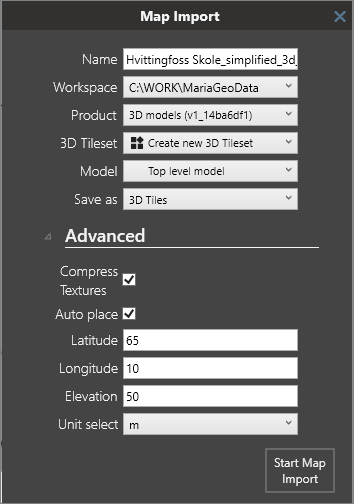3D Tiles
Maria Map Maker is capable of importing, rendering and editing 3D models from a variety of sources. The format used for storage is 3D Tiles. A collection of models in the 3D Tiles format is called a 3D Tileset, and contains all information about geographical position, textures and transformations to correctly place and render a model on a 3D globe.
Import
Importing models is handled by the library assimp. A full list of supported formats can be found at https://github.com/assimp/assimp/blob/master/doc/Fileformats.md, however many of the formats have not yet been tested in Maria Map Maker.
Parameters
- 3D Tileset - Choose an existing 3D tileset as a destination for the model, or create a new tileset.
- Model - Choose an existing model as a parent for the current import, or define it as a top-level model.
- Compress textures - Compress textures into a DirectDraw Surface container file. This reduces file size, but should not be used if you intend to use the tileset in the Cesium platform, as it's not supported there.
- Auto place - Attempt to find geographic position for the model in the source files.
- Latitude / Longitude / Elevation - Manually enter position and elevation for the placement of the model. Only used if "Auto place" is disabled or unable to find geographic position in the source files.
- Unit select - Unit in the source data - meters or feet.
3D Tileset editor
When you open a 3D tileset, Maria Map Maker will enable 3D mode, which will render the background map on top of the highest resolution elevation data available in your workspace (or external sources). There are several ways to navigate the 3D environment:
| Movement | Mouse / keyboard |
|---|---|
| Move along the surface | Left mouse button on the terrain or keyboard arrow buttons or WASD keys. Use Ctrl to move slower. |
| Tilt and rotate camera around a point | Right mouse button |
| Move along the camera direction | Mouse wheel up/down |
